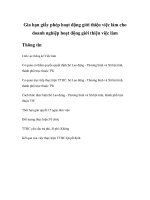Giới thiệu về Kỹ thuật mạng di động. GSM, 3GWCDMA, LTE và Đường đến 5G củaKukushkin, alexander
Bạn đang xem bản rút gọn của tài liệu. Xem và tải ngay bản đầy đủ của tài liệu tại đây (10.9 MB, 401 trang )
Introduction to Mobile Network Engineering
Introduction to Mobile Network Engineering
GSM, 3G-WCDMA, LTE and the Road to 5G
Alexander Kukushkin
PhD, Australia
This edition first published 2018
© 2018 John Wiley & Sons Ltd
All rights reserved. No part of this publication may be reproduced, stored in a retrieval system, or
transmitted, in any form or by any means, electronic, mechanical, photocopying, recording or otherwise,
except as permitted by law. Advice on how to obtain permission to reuse material from this title is available
at />The rights of Alexander Kukushkin to be identified as the author of this work has been asserted in
accordance with law.
Registered Offices
John Wiley & Sons, Inc., 111 River Street, Hoboken, NJ 07030, USA
John Wiley & Sons Ltd, The Atrium, Southern Gate, Chichester, West Sussex, PO19 8SQ, UK
Editorial Office
The Atrium, Southern Gate, Chichester, West Sussex, PO19 8SQ, UK
For details of our global editorial offices, customer services, and more information about Wiley products
visit us at www.wiley.com.
Wiley also publishes its books in a variety of electronic formats and by print-on-demand. Some content that
appears in standard print versions of this book may not be available in other formats.
Limit of Liability/Disclaimer of Warranty
While the publisher and authors have used their best efforts in preparing this work, they make no
representations or warranties with respect to the accuracy or completeness of the contents of this work and
specifically disclaim all warranties, including without limitation any implied warranties of merchantability or
fitness for a particular purpose. No warranty may be created or extended by sales representatives, written
sales materials or promotional statements for this work. The fact that an organization, website, or product is
referred to in this work as a citation and/or potential source of further information does not mean that the
publisher and authors endorse the information or services the organization, website, or product may provide
or recommendations it may make. This work is sold with the understanding that the publisher is not engaged
in rendering professional services. The advice and strategies contained herein may not be suitable for your
situation. You should consult with a specialist where appropriate. Further, readers should be aware that
websites listed in this work may have changed or disappeared between when this work was written and when
it is read. Neither the publisher nor authors shall be liable for any loss of profit or any other commercial
damages, including but not limited to special, incidental, consequential, or other damages.
Library of Congress Cataloging-in-Publication Data
Names: Kukushkin, Alexander, author.
Title: Introduction to mobile network engineering : GSM, 3G-WCDMA, LTE and
the road to 5G / by Alexander Kukushkin.
Description: Hoboken, NJ : John Wiley & Sons, 2018. | Includes
bibliographical references and index. |
Identifiers: LCCN 2018012499 (print) | LCCN 2018021194 (ebook) | ISBN
9781119484103 (pdf ) | ISBN 9781119484226 (epub) | ISBN 9781119484172
(cloth)
Subjects: LCSH: Mobile communication systems. | Wireless metropolitan area
networks.
Classification: LCC TK5103.2 (ebook) | LCC TK5103.2 .K85 2018 (print) | DDC
621.3845/6–dc23
LC record available at />Cover design by Wiley
Cover image: © pluie_r/Shutterstock
Set in 10/12pt WarnockPro by SPi Global, Chennai, India
10
9
8
7
6
5
4
3
2
1
To my family
vii
Contents
Foreword xvii
Acknowledgements xix
Abbreviations xxi
1
Introduction 1
2
Types of Mobile Network by Multiple-Access Scheme
3
Cellular System 5
3.1
3.2
3.3
3.4
3.5
3.6
3.7
3.8
3.9
3.10
3.10.1
3.10.2
3.10.3
Historical Background 5
Cellular Concept 5
Carrier-to-Interference Ratio 6
Formation of Clusters 8
Sectorization 9
Frequency Allocation 10
Trunking Effect 11
Erlang Formulas 13
Erlang B Formula 13
Worked Examples 14
Problem 1 14
Problem 2 16
Problem 3 16
4
Radio Propagation
3
4.1
4.1.1
4.1.2
19
Propagation Mechanisms 19
Free-Space Propagation 19
Propagation Models for Path Loss (Global Mean) Prediction 22
5
Mobile Radio Channel 27
5.1
5.1.1
5.1.2
5.1.3
5.2
Channel Characterization 28
Narrowband Flat Channel 31
Wideband Frequency Selective Channel 31
Doppler Shift 34
Worked Examples 36
viii
Contents
5.2.1
5.2.2
5.3
5.3.1
5.3.2
5.4
5.4.1
5.5
5.5.1
5.5.2
5.5.3
5.6
Problem 1 36
Problem 2 36
Fading 36
Shadowing/Slow Fading 37
Fast Fading/Rayleigh Fading 40
Diversity to Mitigate Multipath Fading 42
Space and Polarization Diversity 42
Worked Examples 44
Problem 1 44
Problem 2 44
Problem 3 45
Receiver Noise Factor (Noise Figure) 45
6
Radio Network Planning 49
6.1
6.1.1
6.1.2
6.1.2.1
6.1.2.2
6.1.2.3
6.1.2.4
6.1.2.5
6.1.2.6
6.1.2.7
6.1.3
6.1.4
6.2
6.2.1
6.2.2
6.2.3
Generic Link Budget 49
Receiver Sensitivity Level 50
Design Level 50
Rayleigh Fading Margin 51
Lognormal Fading Margin 51
Body Loss 51
Car Penetration Loss 51
Design Level 51
Building Penetration Loss 52
Outdoor-to-Indoor Design Level 52
Power Link Budget 52
Power Balance 53
Worked Examples 56
Problem 1 56
Problem 2 57
Problem 3 58
7
Global System Mobile, GSM, 2G 59
7.1
7.2
7.2.1
7.2.2
7.2.3
7.2.4
7.2.5
7.2.6
7.2.7
7.2.8
7.2.9
7.2.10
7.2.11
7.2.12
7.3
General Concept for GSM System Development 59
GSM System Architecture 59
Location Area Identity (LAI) 62
The SIM Concept 63
User Addressing in the GSM Network 63
International Mobile Station Equipment Identity (IMEI) 63
International Mobile Subscriber Identity (IMSI) 64
Different Roles of MSISDN and IMSI 64
Mobile Station Routing Number 64
Calls to Mobile Terminals 65
Temporary Mobile Subscriber Identity (TMSI) 66
Security-Related Network Functions: Authentication and Encryption 66
Call Security 67
Operation and Maintenance Security 69
Radio Specifications 69
Contents
7.3.1
7.3.2
7.3.3
7.3.4
7.3.4.1
7.3.4.2
7.3.4.3
7.3.4.4
7.3.4.5
7.3.5
7.3.5.1
7.3.5.2
7.3.5.3
7.3.5.4
7.4
7.4.1
7.5
7.5.1
7.5.2
7.5.2.1
7.5.2.2
7.6
7.6.1
7.6.2
7.6.2.1
7.6.3
7.6.4
7.6.4.1
7.6.4.2
7.6.5
7.6.5.1
7.6.5.2
7.6.5.3
7.7
7.7.1
7.7.2
7.7.2.1
7.7.2.2
7.7.2.3
7.7.2.4
7.7.2.5
7.7.3
7.8
7.8.1
7.8.2
7.9
7.9.1
Spectrum Efficiency 69
Access Technology 71
MAHO and Measurements Performed by Mobile 72
Time Slot and Burst 73
Normal Burst 74
Frequency Correction Burst (FB) 74
Synchronization Burst 75
Access Burst 75
Dummy Burst 75
GSM Adaptation to a Wideband Propagation Channel 76
Training Sequence and Equalization 76
The Channel Equalization 77
Diversity Against Fast Fading 78
Frequency Hopping 79
Background for the Choice of Radio Parameters 81
Guard Period, Timing Advance 83
Communication Channels in GSM 84
Traffic Channels (TCHs) 84
Control Channels 85
Common Control Channels 85
Dedicated Control Channels 86
Mapping the Logical Channels onto Physical Channels 86
Frame Format 87
Transmission of User Information: Fast Associated Control Channel 88
Data Rates 88
Signalling Multiframe, 51-Frame Multiframe 88
Synchronization 89
Frequency Synchronization 90
Time Synchronization 90
Signalling Procedures over the Air Interface 90
Synchronization to the Base Station 90
Registering With the Base Station 91
Call Setup 91
Signalling During a Call 93
Measuring the Signal Levels from Adjacent Cells 93
Handover 94
Intra-Cell and Inter-Cell Handover 95
Intra- and Inter-BSC Handover 95
Intra- and Inter-MSC Handover 95
Intra- and Inter-PLMN Handover 95
Handover Triggering 95
Power Control 96
Signal Processing Chain 97
Speech and Channel Coding 97
Reordering and Interleaving of the TCH 99
Estimating Required Signalling Capacity in the Cell 100
SDCCH Configuration 100
ix
x
Contents
7.9.2
7.9.2.1
Worked Example 101
Problem 1 101
References 102
8
8.1
8.2
8.3
8.4
8.4.1
8.4.1.1
8.4.1.2
8.4.1.3
8.4.2
8.4.3
8.5
8.5.1
8.5.2
8.5.3
8.5.3.1
8.5.4
8.5.5
8.5.6
8.5.6.1
8.5.6.2
8.5.7
8.5.7.1
8.5.7.2
8.5.8
8.6
8.6.1
8.7
103
GPRS Support Nodes 103
GPRS Interfaces 104
GPRS Procedures in Packet Call Setups 104
GPRS Mobility Management 105
Mobility Management States 106
IDLE State 106
READY State 106
STANDBY State 106
PDP Context Activation 107
Location Management 108
Layered Overview of the Radio Interface 108
SNDP 108
Layer Services 109
Radio Link Layer 110
RLC Block Structure 110
GPRS Logical Channels 111
Mapping to Physical GPRS Channels 111
Channel Sharing 112
Downlink Radio Channel 113
Uplink Radio Channel 113
TBF 113
TBF Establishment 113
DL TBF Establishment 113
EGPRS Channel Coding and Modulation 115
GPRS/GSM Territory in a Base-Station Transceiver 115
PS Capacity in the Base Station/Cell 116
Summary 118
References 119
9
Third Generation Network (3G), UMTS 121
9.1
9.1.1
9.1.2
9.1.3
9.1.4
9.1.4.1
9.1.4.2
9.1.5
9.1.5.1
9.1.5.2
9.1.5.3
9.1.6
The WCDMA Concept 123
Spreading (Channelization) 124
Scrambling 127
Multiservice Capacity 128
Power Control 129
Open-Loop Power Control 130
Outer-Loop Power Control 130
Handover 132
Softer Handover 132
Other Handovers 134
Compressed Mode 134
RAKE Reception 135
EGPRS: GPRS/EDGE
Contents
9.2
9.3
9.4
9.4.1
9.5
9.5.1
9.5.2
9.6
9.6.1
9.6.2
9.6.3
9.6.4
9.7
9.7.1
9.7.2
9.7.2.1
9.7.2.2
9.7.3
9.7.4
9.8
9.8.1
9.8.2
9.8.3
9.8.4
9.8.4.1
9.8.4.2
9.9
9.9.1
9.9.2
9.9.3
9.9.4
9.10
9.10.1
9.10.2
9.10.3
9.10.4
9.11
9.12
Major Parameters of 3G WCDMA Air Interface 136
Spectrum Allocation for 3G WCDMA 136
3G Services 138
Bearer Service and QoS 138
UMTS Reference Network Architecture and Interfaces 140
The NodeB (Base Station) Functions in the 3G Network 141
Role of the RNC in 3G Network 141
Air-Interface Architecture and Processing 142
Physical Layer (Layer 1) 144
Medium Access Control (MAC) on Layer 2 144
Radio Link Control (RLC) on Layer 2 145
RRC on Layer 3 in the Control Plane 145
Channels on the Air Interface 146
Logical Channels 146
Transport Channels 146
Dedicated Transport Channel (DCH) 147
Common Transport Channels 147
Physical Channels and Physical Signals 148
Parameters of the Transport Channel 148
Physical-Layer Procedures 150
Processing of Transport Blocks 151
Spreading and Modulation 154
Modulation Scheme in UTRAN FDD 155
Composition of the Physical Channels 157
Dedicated Physical Channel 157
Common Downlink Physical Channels 160
RRC States 162
Idle Mode 162
RRC Connected Mode 164
RRC Connection Procedures 165
RRC State Transition Cases 166
RRM Functions 167
Admission Control Principle 167
Load/Congestion Control 168
Code Management 168
Packet Scheduling 168
Initial Access to the Network 169
Summary 170
References 171
10
High-Speed Packet Data Access (HSPA) 173
10.1
10.2
10.2.1
10.2.2
HSDPA, High-Speed Downlink Packet Data Access 173
HSPA RRM Functions 175
Channel-Dependent Scheduling for HS-DSCH 175
Rate Control, Dynamic Resource Allocation, Adaptive Modulation
and Coding 176
Hybrid-ARQ with Soft Combining, HARQ 176
10.2.3
xi
xii
Contents
10.2.4
10.2.5
10.2.6
10.3
10.4
10.4.1
10.4.2
10.4.2.1
10.4.3
10.5
10.5.1
10.5.2
10.6
10.6.1
10.6.2
10.6.2.1
10.6.2.2
10.6.3
10.6.4
10.6.4.1
10.6.4.2
10.6.4.3
10.6.4.4
10.6.4.5
10.6.4.6
10.6.4.7
10.6.5
10.6.5.1
10.6.5.2
10.7
Retransmission Mechanism in the NodeB 176
Impact to Protocol Architecture 177
HARQ Schemes 178
MAC-hs and Physical-Layer Processing 181
HSDPA Channels 182
High-Speed Downlink Shared Channel (HS-DSCH) 182
HSDPA Control Channels 183
Fractional Downlink Power Control Channel 184
HS-DSCH Link Adaptation 184
HSUPA (Enhanced Uplink, E-DCH) 189
Control Signalling 190
Scheduling 190
Air-Interface Dimensioning 192
Input Parameters and Requirements 192
Traffic Demand Estimation 193
PS Data Services (Release 99) 193
HSPA Data Services 193
Standard Traffic Model 194
Link Budgets 195
Uplink Load Factor 196
Downlink Load Factor 197
Link Budget for R99 Bearers 198
Link Budget for HSPA 199
Results of Link Budget: Cell Range Calculation, Balancing UL with DL
Link Budget for Common Pilot Channel Signal 200
Link Budget Calculation for the Shared Release 99 and HSDPA
Carriers 200
Uplink Capacity Estimation 201
Required Bandwidth and Load for Multiple Bearers with GOS
Considerations 202
Simplified Estimation of HSDPA Throughput Capacity 202
Summary 203
References 204
11
4G-Long Term Evolution (LTE) System 205
11.1
11.2
11.3
11.3.1
11.4
11.5
11.5.1
11.6
11.7
11.8
11.8.1
11.8.2
Introduction 205
Architecture of an Evolved Packet System 206
LTE Integration with Existing 2G/3G Network 207
EPS Reference Points and Interfaces 208
E-UTRAN Interfaces 209
User Equipment 210
LTE UE Category 210
QoS in LTE 211
LTE Security 212
LTE Mobility 214
Idle Mode Mobility 214
ECM-CONNECTED Mode Mobility 215
199
Contents
11.8.3
11.8.4
11.8.5
11.8.6
11.9
11.10
11.11
11.12
11.13
11.14
11.15
11.16
11.17
11.18
11.19
11.20
11.21
11.21.1
11.21.2
11.22
11.23
11.23.1
11.23.2
11.23.3
11.23.4
11.23.5
11.23.6
11.23.7
11.24
11.24.1
11.24.2
11.24.3
11.24.4
11.24.5
11.24.6
11.24.7
11.24.7.1
11.24.7.2
11.24.7.3
11.24.7.4
11.24.7.5
11.24.7.6
11.25
11.25.1
11.25.2
11.25.3
11.25.3.1
Mobility Anchor 216
Inter-eNB Handover 216
3GPP Inter-RAT Handover 218
Differences in E-UTRAN and UTRAN Mobility 218
LTE Radio Interface 219
Principle of OFDM 220
OFDM Implementation using IFFT/FFT Processing 223
Cyclic Prefix 223
Channel Estimation and Reference Symbols 225
OFDM Subcarrier Spacing 227
Output RF Spectrum Emissions 227
LTE Multiple-Access Scheme, OFDMA 228
Single-Carrier FDMA (SC-FDMA) 229
OFDMA versus SC-FDMA Operation 230
SC-FDMA Receiver 231
User Multiplexing with DFTS-OFDM 231
MIMO Techniques 232
Precoding 234
Cyclic Delay Diversity (CDD) 236
Link Adaptation and Frequency Domain Packet Scheduling 237
Radio Protocol Architecture 238
User Plane 239
Control Plane 239
Scheduler 240
Logical and Transport Channels 240
Physical Layer 242
RRC State Machine 244
Time-Frequency Structure of the LTE FDD Physical Layer 244
Downlink Physical Layer Processing 248
Multiplexing and Channel Coding for Downlink Transport Channels 248
CRC Computation and Attachment to the Transport Block 248
Code Block Segmentation and Code Block CRC Attachment 249
Channel Coding 249
Rate Matching for Turbo Coded Transport Channels 249
Downlink Control Information Coding 250
Physical Channel Processing 250
Bit-Level Scrambling 251
Data Modulation 251
Layer Mapping 252
Precoding 252
Mapping to Resource Elements 255
Downlink Reference Signals 256
Downlink Control Channels 258
Structure of the Synchronization Channel 258
Time-Domain Position of Synchronization Signals 259
Frequency Domain Structure of Synchronization Signals 259
PSS Structure 259
xiii
xiv
Contents
11.25.3.2
11.25.4
11.25.5
11.25.6
11.25.7
11.26
11.27
11.27.1
11.27.2
11.27.3
11.27.4
11.27.5
11.27.6
11.27.7
11.28
11.28.1
11.29
11.29.1
11.29.2
11.29.3
11.29.4
11.29.5
11.29.6
11.30
11.30.1
11.30.1.1
11.30.1.2
11.30.1.3
11.30.1.4
11.30.1.5
11.30.1.6
11.30.1.7
11.30.2
11.31
SSS Structure 260
PBCH 260
Physical Control Format Indicator Channel: PCFICH 262
PDCCH 263
PHICH, Physical Hybrid-ARQ Indicator Channel 264
Mapping the Control Channels to Downlink Transmission Resources 264
Uplink Control Signalling 264
Processing of the Uplink Shared Transport Channel 266
Channel Coding of Control Information 266
Multiplexing and Channel Interleaving 266
Processing for Physical Uplink Shared Channel 268
Physical Uplink Control Channel, PUCCH 269
Multiplexing of UEs Within a PUCCH 269
Physical Random Access Channel (PRACH) 270
Uplink Reference Signals 271
Mapping of Reference Signals to the Uplink Frame Structure 272
Physical-Layer Procedures 273
Cell Search 273
Random Access Procedure 274
Link Adaptation 276
Power Control 277
Paging 278
HARQ 278
LTE Radio Dimensioning 279
LTE Coverage Dimensioning: Link Budget 280
Physical-Layer Overhead Factors 281
Multi-Antenna Systems 284
Required SINR 285
Link Budget Margins 285
Interference Margin 285
Maximum Allowable Path Loss (MAPL) 287
Required SINR 288
Cell Range and Cell Capacity 288
Summary 289
References 290
12
12.1
12.2
12.3
12.3.1
12.3.2
12.3.3
12.4
12.4.1
12.4.2
12.4.3
LTE-A 293
Carrier Aggregation 296
Enhanced MIMO 300
Coordinated Multi-Point Operation (CoMP) 303
CoMP Categories 304
Downlink CoMP 306
Uplink CoMP 307
Relay Nodes 309
Relay Radio Access 309
Relay Architecture 311
Resource Assignment for DeNB-RN Link in a Type 1 Relay 314
Contents
12.5
12.6
12.7
Enhanced Physical Downlink Control Channel (E-PDCCH) 315
Downlink Multiuser Superposition, MUST 315
Summary of LTE-A Features 317
References 317
13
Further Development for the Fifth Generation
13.1
13.2
13.3
13.4
13.5
13.5.1
13.5.1.1
13.5.1.2
13.5.1.3
13.5.1.4
13.5.1.5
13.5.1.6
13.5.1.7
13.5.2
13.5.2.1
13.5.2.2
13.5.2.3
13.5.2.4
13.6
13.6.1
13.6.2
13.6.3
13.6.3.1
13.6.3.2
13.6.3.3
13.6.3.4
13.7
13.7.1
13.7.2
13.7.3
13.7.3.1
13.7.4
13.7.5
13.7.5.1
13.7.5.2
13.7.6
13.7.6.1
13.7.7
13.7.7.1
13.7.7.2
13.7.8
319
Overall Operational Requirements for a 5G Network System 320
Device Requirements 320
Capabilities of 5G 321
Spectrum Consideration 321
5G Technology Components 322
Technologies to Enhance the Radio Interface 322
Advanced Modulation-and-Coding Schemes 323
Non-Orthogonal Multiple Access (NOMA) 323
Active Antenna System (AAS) 326
3D Beamforming and Multiuser MIMO (MU-MIMO) 327
Massive MIMO 328
Full Duplex Mode 329
Self-Backhauling 330
Technologies to Enhance Network Architectures 331
Software-Defined Network 332
Cloud RAN 332
Network Slicing 332
Self-Organized Network, SON 334
5G System Architecture (Release 15) 335
General Concepts 335
Architecture Reference Model 335
Network Slicing Support 338
General Framework 338
Network Slice Selection Assistance Information (NSSAI) 338
Selection of a Serving AMF Supporting the Network Slices 339
UE Context Handling 340
New Radio (NR) 341
NG-RAN Architecture 341
Functional Split 342
Network Interfaces 343
NG Interface 343
Xn Interface 345
NG-RAN Distributed Architecture 346
F1 Interface Functions 347
F1 Protocol Structure 347
Radio Protocol Architecture 348
User Plane 348
NR Physical Channels and Modulation 350
Physical-Layer Design Requirements 350
Frame Structure and Physical Resources 352
Frames and Subframes 353
xv
xvi
Contents
13.7.9
13.7.9.1
13.7.9.2
13.7.10
13.7.11
13.7.12
13.7.13
13.7.14
13.7.15
13.7.16
13.7.16.1
13.7.16.2
13.8
Physical Resources 354
Resource Grid 354
Resource Blocks 355
Carrier Aggregation 356
Uplink Physical Channels and Signals 356
Downlink Physical Channels and Signals 357
SS/PBCH Block 358
Coding and Multiplexing 359
NR Dual Connectivity 359
E-UTRA and NR Multi-RAT Dual Connectivity 360
Bearer Types for MR-DC Between LTE and NR 362
MR-DC User-Plane Connectivity 363
Summary 364
References 364
14
Annex: Base-Station Site Solutions 367
14.1
14.1.1
14.1.2
14.1.3
14.2
14.3
14.4
14.4.1
The Base-Station OBSAI Architecture 367
Functional Modules 367
Internal Interfaces 369
RP3 Interface 369
Common Public Radio Interface, CPRI 370
SDR and Multiradio BTS 371
Site Solution with OBSAI Type Base Stations 372
C-RAN Site Solutions 374
References 375
Index 377
xvii
Foreword
From the 1990s to the present, three generations of mobile radio networks have been
deployed in every country of the world. Those networks connect billions of customers
and provide mobile communications services. Mobile radio communications have
become ubiquitous throughout the world. People are getting used to the technology
through commercial mobile phones. The mobile network infrastructure that enables
communications has become a normal part of the urban environment in which people
live. There is also a great number of other applications for mobile radio that are essential
in the modern world and are used in navigation, transportation, machine-to-machine
communications (M2M), robotics, emergency and low enforcement services, broadcasting, space exploration, the military, and so on. The mobile radio is, in fact, a part
of a more widely defined wireless technology that, of course, includes wireless LANs
(Wi-Fi) with fixed and nomadic access.
The content of this book is limited to three major mobile communication technologies: GSM, 3G-WCDMA and LTE with the major focus on Radio Access Network (RAN)
technology. We introduce some basic concepts of mobile network engineering used in
the design and rollout of mobile networks. Then we cover principles, design constraints
and provide a more advanced insight into the radio interface protocol stack, operation and dimensioning for three major mobile network technologies; the Global System
Mobile (GSM), third (3G-WCDMA) and fourth generation (4G-LTE) mobile technologies that have been recently deployed or are shortly to be deployed. Enhancements of
fourth generation technology in LTE-Advanced (LTE-A) are described at the level of
conceptual design.
The concluding sections of the book are concerned with further development
towards the next generation of mobile networks (5G). The last section describes some
key concepts that may bring significant enhancements in network operation efficiency
and quality of services experienced by customers. A development of the fifth generation
of mobile networks can be regarded as a mix of evolutionary advances in 4G LTE
through LTE-A and new radio technology likely operating in newly allocated spectrum
bands. This development covers a broad area of applications and many different topics
that require specifically dedicated study. Therefore, many interesting and important
topics such as the Internet of Things, massive MTC, developments in new technology
for emergency services based on LTE, integration of the mobile radio access network
and Wi-Fi are out of the scope of this book.
Since the standards for 5G are still in development, most of the features of the new radio
technology are related to 3GPP Release 15. Some breakthrough technological advances
xviii
Foreword
are planned for further releases of 5G, such as a Full Duplex and self-backhauling
and are described as concepts rather than commercially available technology.
While many excellent books on mobile radio networking are available, I think many
more will be published in the near future since the subject is continuously evolving.
This book is intended to provide a generalist and compressed description of major technologies utilized in the radio access part of modern mobile networks. I envisage readers
are engineers in relatively early stages of their careers in the mobile wireless industry.
Some of them may be taking a post-graduate course to enhance their knowledge. They
may include operation support engineers, technical sale/presale engineers, technical
and account managers who may need or wish to enhance or expand their knowledge of
mobile network system engineering. Each major technology section of the book consists
of introductory material, a more advanced part and a summary.
Alexander Kukushkin
xix
Acknowledgements
I thank Professor Branka Vucetic, School of Electrical and Information Engineering,
University of Sydney, for the invitation to teach at the University that led to the writing
of this book. I wish to thank the reviewers of the book for their constructive comments
that helped to improve and extend the content, especially on the 5G related topics.
xxi
Abbreviations
3G
3GPP
5G
5GC
5G-S
TMSI
AA
AAA
AAS
ACK
ADC
AF
AGCH
AICH
AKA
AM
AMC
AMF
AMR
ARFCN
ARQ
ATCA
AUC
AUSF
BALUN
BBU
BCCH
BCH
BLER
BMC
BS
BSC
BSIC
BSS
CA
Third Generation
3rd Generation Partnership Project
Fifth Generation of mobile networks
5G Core network
5G System
Temporary Mobile Subscription Identifier
Antenna Array
Authentication, Authorization & Accounting
Active Antenna System
ACKnowledgement
Analogue to Digital Converter
Application Function
Access Grant CHannel
Acquisition Indicator CHannel
Authentication and Key Agreement
Acknowledged Mode
Adaptive Modulation and Coding
Access and Mobility Management Function
Adaptive Multi-Rate (coding)
Absolute Radio Frequency Channel Number
Automatic Repeat reQuest
Advanced Telecommunications Computing Architecture
AUthentication Centre
Authentication Server Function
BALanced to UNbalanced conversion
Base Band Unit
Broadcast Control CHannel
Broadcast CHannel
BLock Erasure Rate
Broadcast/Multicast Control
Base Station
Base Station Controller
Base Station Identity Code
Base Station Subsystem
Carrier Aggregation
xxii
Abbreviations
CAC
CC
CCCH
CCE
CCPCH
CCTrCH
CDD
CDM
CDMA
CIR
COMP
CP
CPCH
CPICH
CP-OFDM
CPRI
CQI
C-RAN
CRC
CRNC
CRNTI
CRS
CSCH
CSFB
CSI
CSI-RS
CTCH
DAC
DC
DCCH
DCH
DCI
DeNB
DFT
DFTS-OFDM
DL PCC
DL SCC
DLL
DL-SCH
DMRS
DN
DNN
DPCCH
DPCH
DPD
DPDCH
DRNC
Call Admission Control
Component Carrier
Common Control Channel
Control Channel Element
Common Control Physical Channel
Coded Composite Transport Channel
Cyclic Delay Diversity
Code Division Multiplexing
Code Division Multiple Access
Carrier to Interference Ratio
COordinated MultiPoint transmission and reception
Cyclic Prefix
Common Packet Channel
Common Pilot Channel
Cyclic Prefix-OFDM
Common Public Radio Interface
Channel Quality Indicators
Centralized Radio Access Network
Cyclic Redundancy Check
Controlling RNC
Cell Radio Network Temporary Identifier
Cell RS
Compact Synchronization Channel
Circuit Switched Fall Back
Channel State Information
Channel State Information Reference Signal
Common Traffic Channel
Digital-to-Analogue Convertor
Dual Connectivity
Dedicated Control Channel
Dedicated Transport Channel
Downlink Control Information
Donor eNB
Discrete Fourier Transform
DFT Spread-OFDM
Downlink Primary Component Carrier
Downlink Secondary Component Carrier
Data Link Layer
Downlink Shared CHannel
DeModulation Reference Signal
Data Network
Data Network Name
Dedicated Physical Control CHannel
Dedicated Physical CHannel
Digital Pre-Distortion
Dedicated Physical Data Channel
Drift RNC
Abbreviations
DRX
DSCH
DTCH
e2e
E-AGCH
ECCE
ECM
E-DCH
EDGE
E-DPCCH
E-HICH
EIR
eMBB
EN-DC
EPC
EPDCCH
EPS
EREG
E-RGCH
E-TFC
ETSI
E-UTRA
E-UTRAN
FACCH
FACH
FBI
FCCH
FDD
FDM
FDMA
F-DPCH
FDPS
FEC
FER
FFT
FN
FR
GBR
GGSN
GMSC
GMSK
GPRS
GSM
GTP
HARQ
HLR
HR
Discontinuous Transmission and Reception
Downlink Shared Channel
Dedicated Traffic Channel
End to End
E-DCH Absolute Grant CHannel
Enhanced Control Channel Element
EPS Connection Management
Enhanced Dedicated Channel
Enhanced Data rate for GSM Evolution
E-DCH Dedicated Physical Control CHannel
E-DCH Hybrid ARQ Indicator CHannel
Equipment Identity Register
Enhanced Mobile Broadband
E-UTRA-NR Dual Connectivity
Evolved Packet Core
Enhanced Physical Downlink Control CHannel
Evolved Packet System
Enhanced Resource Element Group
E-DCH Relative Grant Channel
E-DCH Transport Format Combination
European Telecommunications Standards Institute
Evolved UMTS Radio Access
Evolved UTRAN
Fast Associated Control Channel
Forward Access Channel
Feedback Information
Frequency Correction Channel
Frequency Division Duplex
Frequency Division Multiplexing
Frequency Division Multiple Access
Fractional DPCH
Frequency Domain Packet Scheduling
Forward Error Correction
Frame-Error Rate
Fast Fourier Transform
Frame Number
Full Rate
Guaranteed Bit Rate
Gateway GPRS Support Node
Gateway MSC
Gaussian Minimum Shift Keying modulation
GSM Packet Radio Service
Global System Mobile
GPRS Tunnelling Protocol
Hybrid ARQ
Home Location Register
Half Rate
xxiii
xxiv
Abbreviations
HSDPA
HS-DPCCH
HS-DSCH
HSS
HS-SCCH
HSUPA
HW
iFFT
IMEI
IMS
IMSI
IPsec
ISHO
ISI
IWF
LA
LAC
LAI
LAN
LLC
LNA
LOS
LPMA
LTE
M2M
MAC
MAHO
MAPL
MCC
MCG
MCS
MeNB
MgNB
MHA
MIB
MIMO
MME
MMI
MN
MNC
MRC
MR-DC
MS
MSC
MSISDN
MSRN
MT
High Speed Downlink Packet Access
High-Speed Dedicated Physical Control CHannel
High-Speed Downlink Shared CHannel
Home Subscriber Server
High-Speed Shared Control Channel
High Speed Uplink Packet Access
Hardware
inverse FFT
International Mobile Station Equipment Identity
IP Multimedia Subsystem
International Mobile Subscriber Identity
IP Security protocol
Inter-System Handover
Inter-Symbol Interference
Interworking Function
Location Area
Location Area Code
Location Area Identifier
Local Area Network
Logical Link Control
Low Noise Amplifier
Line Of Sight
Lattice Partition Multiple Access
Long Term Evolution
Machine to Machine communications
Medium Access Control
Mobile Assisted HandOver
Maximum Allowable Path Loss
Mobile Country Code
Master Cell Group
Modulation Coding Scheme
Master eNB
Master gNB
Mast Head Amplifier
Master Information Block
Multiple Input Multiple Output
Mobility Management Entity
Man-Machine Interface
Master Node
Mobile Network Code
Maximum Ratio Combining
Multi-RAT Dual Connectivity
Mobile Station (mobile phone)
Mobile Switching Centre
Mobile Subscriber ISDN Number
Mobile Station Routing Number
Mobile Termination
Abbreviations
MTC
MTCH
MU-MIMO
MUST
NACK
NAS
NB-IoT
NDC
NE-DC
NEF
NF
NFV
NGEN-DC
NGMN
NG-RAN
NOMA
NR
NRF
NSS
NSSAI
NSSF
OAM
OBSAI
OFDMA
OMC
OSI
OSS
OVP
OVSF
PACCH
PAPR
PCC
PCCCH
P-CCPCH
PCell
PCF
PCFICH
PCH
PCPCH
PCRF
PCU
PDCH
PDCP
PDP
PDSCH
PDTCH
PDU
Machine Type Communications
Multicast Traffic Channel
Multi-User MIMO
Multiuser Superposition Transmission
Negative ACKnowledgement
Non-Access Stratum
Narrow-Band Internet of Things
National Destination Code
MR-DC with the 5GC
Network Exposure Function
Network Functions
Network Function Virtualization
NG-RAN E-UTRA-NR Dual Connectivity
Next Generation Mobile Network Alliance
New Generation Radio Access Network
Non-Orthogonal Multiple Access
New Radio
NF Repository Function
Network Switching Subsystem
Network Slice Selection Assistance Information
Network Slice Selection Function
Operation, Administration and Maintenance
Open Base Station Architecture Initiative
Orthogonal Frequency Division Multiple Access
Operation and Maintenance Center
Open System Interconnect
Operation Support Subsystem
Over Voltage Protection
Orthogonal Variable Spreading Factor
Packet Associated Control Channel
Peak-to-Average Power Ratio
Primary Component Carrier
Packet Common Control Channel
Primary Common Control Physical Channel
Primary Cell
Policy Control Function
Physical Control Format Indicator Channel
Paging Channel
Physical Common Packet Channel
Policy Charging and Rules Function
Packet Control Units
Packet Data CHannel
Packet Data Convergence Protocol
Packet Data Protocol
Physical Downlink Shared CHannel
Packet Data Traffic CHannel
Packet Data Unit
xxv
xxvi
Abbreviations
P-GW
PHICH
PICH
PIN
PLMN
PMI
PRACH
PRB
P-RNTI
PSC
P-SCH
PSS
PSTN
PTCCH
PTCH
PT-RS
PUCCH
QCI
QoE
QoS
RAB
RACH
RAN
RAT
RAU
RB
RDN
REG
RF
RI
RLC
RN
RNC
RP
RRC
RRH
RRM
RRU
RS
SACCH
SAE
SAW
SCC
SCell
SC-FDMA
SCG
SCH
Packet Data Network Gateway
Physical Hybrid-ARQ Indicator Channel
Paging Indicator Channel
Personal Identification Number
Public Land Mobile Networks
Precoder Matrix Indication
Physical Random Access Channel
Power Resource Block
Paging Group Identity
Primary Scrambling Code
Primary Synchronization Channel
Primary Synchronization Signal
Public Switching Telephone Network
Packet Timing advance Control Channel
Packet Traffic Channel
Phase-Tracking Reference Signals
Physical Uplink Control CHannel
QoS Class Indicator
Quality Of user Experience
Quality of Service
Radio Access Bearer
Random Access CHannel
Radio Access Network
Radio Access Technology
Routing Area Update
Resource Block
Radio Distribution Network
Resource Element Group
Radio Frequency
Rank Indication
Radio Link Control
Relay Node
Radio Network Controller
Reference Point
Radio Resource Control
Remote Radio Head
Radio Resource Management
Remote Radio Unit
Reference Signals
Slow Associated Control Channel
System Architecture Evolution
Stop-And-Wait
Secondary Component Carrier
Secondary Cell
Single Carrier FDMA
Secondary Cell Group
Synchronization Channel
Abbreviations
S-CPICH
SDCCH
SDN
SDR
SDU
SF
SFN
SFP
SgNB
SGSN
S-GW
SIB
SIC
SIM
SINR
SIP
SIR
SM
SMF
SMG
SN
SecN
SNDCP
S-NSSAI
SON
SRB
SRNC
SRS
S-SCH
SSS
STR
SU-MIMO
SVD
SW
TA
TAB
TAG
TAU
TB
TBF
TCH
TCP
TDMA
TE
TF
TFC
TFCS
Secondary Common Pilot Channel
Standalone Dedicated Control Channel
Software Defined Networking
Software Designed Radio
Service Data Unit
Spreading Factor
System Frame Number
Small Form factor Pluggable
Secondary gNB
Serving GPRS Support Node
Serving Gateway
System Information Block
Successive Interference Cancellation
Subscriber Identity Module
Signal to Interference and Noise Ratio
Session Initiation Protocol
Signal to Interference Ratio
System Module
Session Management Function
Special Mobile Group
Subscriber Number
Secondary Node
Subnetwork Dependent Convergence Protocol
Single Network Slice Selection Assistance Information
Self-Organizing Network
Signalling Radio Bearer
Serving RNC
Sounding RS
Secondary Synchronization Channel
Secondary Synchronization Signal
Simultaneous Transmission and Reception
Single User-MIMO
Singular-Value Decomposition
Software
Terminal Adapter
Transceiver Array Boundary
Timing Advance Group
Tracking Area Update
Transport Block
Temporary Block Flow
Traffic Channel
Transmission Control Protocol
Time Division Multiple Access
Terminal Equipment
Transport Format
Transport Format Combination
Transport Format Combination Set
xxvii









